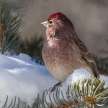
Puna Tinamou occupies the high Andes over Bolivia from southern Peru to northern Chile and Argentina, and grows at higher altitudes than any other tinamou. Relatively rare for a tinamou, the back has conspicuous white lines, a rufous vent, and an olive rump. Birds sometimes enter in groups, and occupy brushy or rocky puna habitats. Under extreme weather we get down to caves and other protected areas. Puna Tinamous does not build a nest or dig, but instead lays their eggs on the ground in the shade of other trees. When the chicks hatch in groups composed of young people from several broods and attended by several males, they may assemble. Tinamous are winged desert birds with very short wings, stocky and rounded. The two species of Tinamotis are very large, with a sharply shaved head and a rufous vent; these tinamous species have a very short body, and just three toes. Also Puna Tinamou has olive tops, more or less, and a sharply barred breast. The genders are identical. Because of its very large size, proudly stripped head and rufous vent within its geographical range, Puna Tinamou is readily identifiable. Puna Tinamou is somewhat similar to Patagonian Tinamou but between those two species there is no geographical similarity. By contrast, Puna Tinamou lacks the rufous remiges of the Patagonian Tinamou. Adults have a patterned, white ear. Very light, almost trimmed, with soothy brown and white buffy crown and nape. Likewise brown and whitish on the sides of head and neck, two very long, parallel streaks outline the pale areas. Upper sections are usually mottled, spotted (back and rump), dark greyish brown, and cinnamon buff barred. Heavily suffused with bright yellowish olive, back sides, rump, and rectrices. Dull brown primaries, notched on outer branches with a pinkish buff. Black or whitish, throat immaculate. Breast, neck, and flanks, and occasionally the upper abdomen, light greyish, profusely barred with a pale ochraceous buff; darker breast, occasionally rufescent. High collar, high flanks and soft rufous cinnamon shine. Puna Tinamou occurs across Northern Chile and Argentina in the High Andes from southern Peru to Bolivia. The distributional northern limit is commonly described as central Peru in Junín, though the sight record is as far north as Ancash. Puna Tinamou occurs in the south to Antofagasta, Chile and Argentina in the northwest. Puna Tinamou occurs "close to the upper limits of the forest." This species prefers tola heat but also shares with scattered cushion plants such as Larretia compacta and coarse grass tussocks, and sometimes scattered Polylepis shrub, other sandy or stony habitats. A diet of Puna Tinamou is not well known. Three contents of three Bolivian stomachs included the leaves of Adesmia, fresh roots, buds, and seeds, as well as a small amount of grass but no insects. At the field, Puna Tinamou forges. This insect glides horizontally with the wings held during flight. Puna Tinamou likes to sprint backwards, sometimes running uphill, to hide. As the head bobs walk back and forth. Usually Puna Tinamous is found in small communities, from three to nine individuals. In Peru, breeding is recorded in June-August. Adults were seen in Northern Chile in January-February and young birds followed. Breeding is also reported from Bolivia, in November. There's no nest at the field here. The clutch contains 5-8 eggs; mean size of the egg is 57.1 x 39.0 mm. The eggs are light yellowish green with whitish granulations, but Johnson thought the eggs will be bright white when fresh, and then slowly turn yellow during incubation. The male incubates the eggs alone and cares for the young. Half grown chicks, reported primarily in December.
About the Creator
MB
I am a bird aficionado and really enjoy spotting them them on hikes. I greatly appreciate the variety of birds cross North America and the world. They are amazing and intelligent creatures, each so unique and with a wonderful life.






Comments
There are no comments for this story
Be the first to respond and start the conversation.